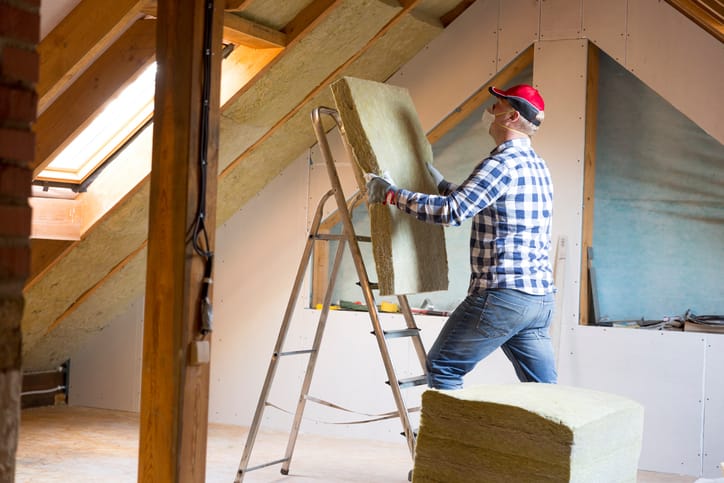Your Attic insulation plays a major role when it comes to the overall comfort of your home and energy efficiency. Insulation can be installed in one of the two places:
- Beneath the Attic roof
- On the attic floor
However, installing attic roof insulation instead of an attic floor installation has a lot of advantages. Properly installed attic roof Insulation has the capability of eliminating a lot of air leaks that are known to waste energy and make certain parts of your house uncomfortable. Getting attic roof insulation done will have better performance from the ductwork that is in your attic. At Attic Insulation Toronto, we prefer cellulose blow-in insulation as the best option for attic restoration projects, you can read more about the advantages of blow-in insulation further in the article.
Foam Insulation is better than Fiberglass
There are many builders who have installed fibreglass batt insulation between the attic rafters to help insulate the cathedral ceilings and attic roofs. However, this technique is not as effective as the more modern methods of roof insulation.
Getting fibreglass insulation can compress and lose R-value, and it is also unable to stop air from leaking out of your home. The better material for your attic roof insulation is foam insulation and rigid foam boards.
Rigid foam board insulation
They come in sheets with different levels of thickness. When you use this material for your attic insulation, it is normally installed between rafters that are directly beneath the attic rafters or sometimes in both locations. Rigid foam just like spray foam will provide air a moisture barrier as well as high R-Value insulation.
Batt and Roll insulation
This is perhaps the most commonly and widely used type of insulation material available. It is usually sold in the form of batts or rolls. It consists of flexible fibres that are commonly fibreglass. You will also find rolls and batts that are made from mineral, plastic fibres, wool and natural fibres such as cotton and sheep’s wool.
Batts and rolls are available in widths that are suited for standard spacing of wall studs, attic trusses or rafters, and floor joists. Continuous rolls of these materials can be hand cut and trimmed to fit. They are available with or without facing.
Manufacturers often attach the facing to act as the air or vapour barrier. You will find batts that have a special flame-resistant facing in various levels of width for your basement walls and other places where your insulation can be left exposed. Your facing will also facilitate the fastening during insulation.
Loose fill blown-in Insulation
They consist of small particles of fibre foam and sometimes other material. These small particles will form the insulation material that will conform to any space without disturbing your roof structures or finished. The ability to conform makes loose-fill insulation well suited for retrofits and locations where it would be difficult to fit any other type of insulation material. The most common type of material that is used for loose-fill insulation include fibreglass, cellulose and mineral wool. These materials are normally produced from recycled waste materials. Cellulose is made from recycled newspapers. Fibreglass material normally contains about 40-60 percent recycled glass. While mineral wool is produced from 75 percent postindustrial recycled content.
Sprayed Foam
Liquid foam insulation materials can be sprayed, foamed in place, poured or injected. Foam-in-place can be blown into walls, under floors or on attic surfaces to help insulate and reduce air leakages. Some of the installations can yield a higher R-value than traditional batt insulation for the same kind of thickness. They have the capability of creating an effective air barrier. You can use the small pressurized cans of foam-in-place insulation to help reduce air leaks in cracks and holes on your door frames, window, plumbing penetrations and electrical.
Foam board or Rigid Foam
They are used for insulation in any part of your home from your foundation all the way up your roof. They are very effective when it comes to interior sheeting for basement walls, exterior wall sheeting and special applications like attic hatches. This attic insulation material provides good thermal resistance that is up to two times greater than other insulation materials when used in the same thickness. They have the capability of reducing head conduction through structural elements like steel studs, and wood. The most common types of materials that are used in making this type of insulation material are polystyrene, polyurethane, and polyisocyanurate.

